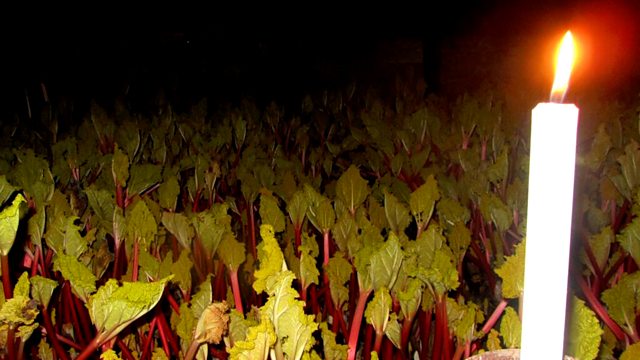Rhubarb
Forced rhubarb is grown in the dark and harvested by candlelight. Caz Graham visits a farm near Leeds, to find out how they are keeping a 137-year-old Yorkshire tradition alive.
Forced rhubarb is a crop not quite like any other. The plants spend two years out in the fields without being harvested, allowing the roots to store energy. They're then transferred into heated sheds, where they're kept in complete darkness. In the warmth, the plants begin to grow, looking for light. The process results in distinctive pink stalks, which - unlike rhubarb grown outdoors - are white inside, and sweeter than the unforced variety. To avoid letting light near the plants, the crop is harvested by candlelight.
With soil and a microclimate well suited to rhubarb, the area between Leeds, Bradford and Wakefield became known as the 'rhubarb triangle'. Production of forced rhubarb began here in 1877, and at its peak, in the years leading up to World War Two, rhubarb production covered an area of around 30 square miles. By the 1940s there were 200 tonnes leaving Yorkshire by train every day on the Rhubarb Express, much of it bound for Covent Garden in London. But with its connotations of wartime rationing and school dinners, rhubarb declined in popularity after the war, as new tropical fruits arrived on the shelves. From a peak of more than 200 forced rhubarb producers in area, there are now just eleven.
In this programme, Caz Graham travels to Carlton near Leeds to talk to Janet Oldroyd Hulme, whose family has been growing forced rhubarb for five generations. Janet also runs tours, showing groups of visitors how this unique crop is produced.
Presented by Caz Graham and produced by Emma Campbell.
Last on
Broadcast
- Sun 9 Mar 2014 06:35麻豆社 Radio 4


